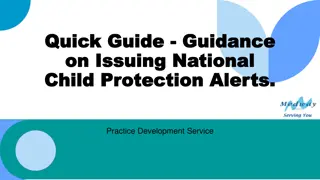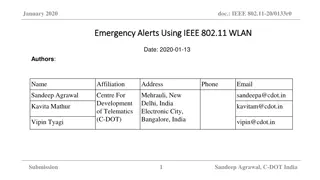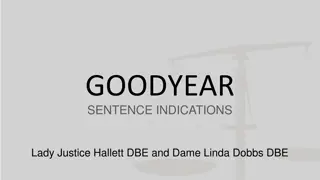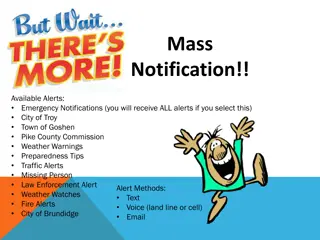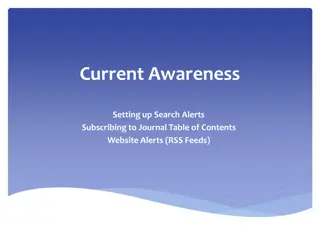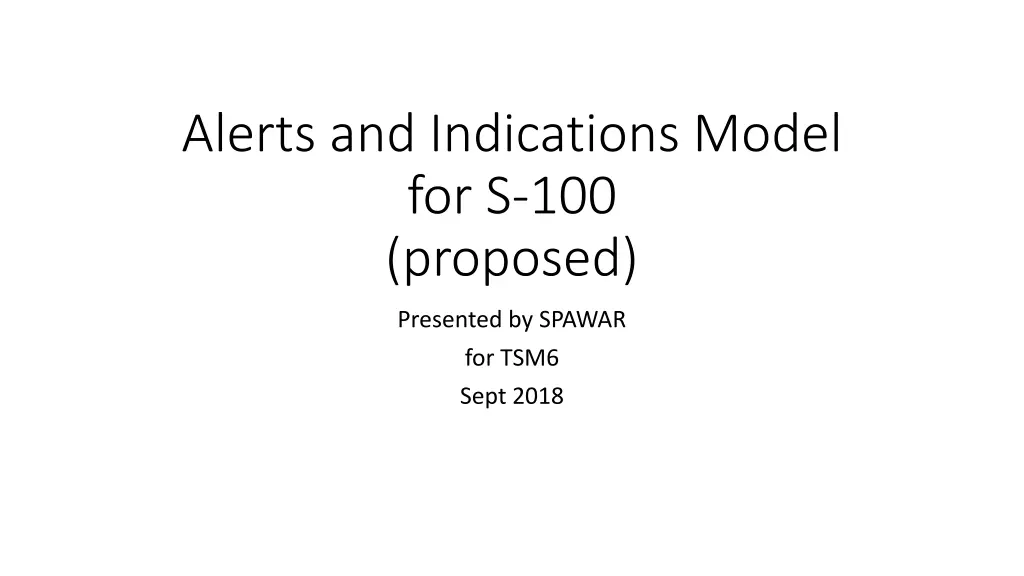
Alerts and Indications Model for S-100 Proposed by SPAWAR
Explore the proposed Alerts and Indications Model for S-100 presented by SPAWAR, highlighting the need for an alert model within S-100, changes in alert requirements, addition of new feature types, and more. Learn about the background, alert instructions, and references related to ECDIS performance standards. Understand the definitions of alerts, priority alarms, warnings, cautions, categories, indications, and more in the maritime safety context.
Download Presentation

Please find below an Image/Link to download the presentation.
The content on the website is provided AS IS for your information and personal use only. It may not be sold, licensed, or shared on other websites without obtaining consent from the author. If you encounter any issues during the download, it is possible that the publisher has removed the file from their server.
You are allowed to download the files provided on this website for personal or commercial use, subject to the condition that they are used lawfully. All files are the property of their respective owners.
The content on the website is provided AS IS for your information and personal use only. It may not be sold, licensed, or shared on other websites without obtaining consent from the author.
E N D
Presentation Transcript
Alerts and Indications Model for S-100 (proposed) Presented by SPAWAR for TSM6 Sept 2018
Background TSMAD28 & TSM3 Hannu presented the need for an alert model defined within S-100 Allow fielded ECDIS systems to respond to changes in alert requirements without software upgrades Addition of alerts from emergent product types Addition of new feature types which generate alerts Changes to pre-existing alert processing rules 2
Background S100WG01-10.12A Alert model based on portrayal model Portrayal Model: Encoded dataset => drawing instructions Alert Model: Encoded dataset => alert instructions Notional model based on XSLT rule files Alert Instructions Identify one or more spatial elements of an encoded dataset to be evaluated by ECDIS alert processing Does not provide spatial processing (manufacturer responsibility) No provision for alerts not generated from a spatial element of a dataset Deviation from route Positioning system failure etc. 3
References IEC 61174:2015 ECDIS performance requirements 62288:2014 Presentation of navigation information on shipborne navigational displays 62616:2010 Bridge navigational watch alarm system (BNWAS) IMO Assembly A.1021(26) Code on alerts and indicators, 2009 Maritime Safety Committee MSC.302(87) Adoption of Performance Standards for Bridge Alert Management MSC.252(83) Revised performance standards for INS MSC.232(82) Revised performance standards for ECDIS 4
Definitions Alert: Announces abnormal situations requiring attention Priority Alarm: Highest priority of alert. Condition requiring immediate attention and action by the bridge team, to maintain the safe navigation of the ship. Warning: Condition requiring no-immediate attention or action by the bridge team. Warnings are presented for precautionary reasons to make the bridge team aware of changed conditions which are not immediately hazardous, but may become so, if no action is taken. Caution: Lowest priority of alert. Awareness of a condition which does not warrant a alarm or warning condition, but still requires attention out of the ordinary consideration of the situation or of given information. Category A: Graphical information at the task station directly assigned to the function generating the alert is necessary, as decision support for the evaluation [of] the alert related condition. B: No additional information for decision support is necessary besides the information which can be presented at the central alert management HMI Indication: Display of regular information and conditions, not part of alert management Permanent Indication: Indication not to be removed from the display Other informal terms are used: e.g. clear indication 5
Required Model Components Alert Trigger condition Mechanism to disable trigger Priority Category Message (text) Crossing safety contour Alarm Warning Caution A B A location for the message An icon (optional?) Selector What happens to active alerts when disabled E.g. Disable anchor watch active alerts should be cleared 6
Required Model Components Alert Graphical Highlight displayed while alert is active Mechanism to disable the highlight Display on demand components A fill symbol (for areas) A line style (for areas and lines) A point symbol (for points) The geometry of the highlight (e.g. intersection of feature and route) Display plane and drawing priority are not currently included Selector An indication displayed when / while the highlight is disabled E.g. Crossing safety contour alert requires display of feature and highlight on demand 7
Required Model Components Indication Indication message (text) Type of indication Location of indication Display on demand components Route planning checks treat Indication as an alert priority An icon (optional?) Permanent Non-permanent? Generally not specified in references, overlaying chart assumed Imprecise in some references, e.g. Close to north arrow E.g. AIS target filter enabled requires display of AIS target filter criteria on demand Requires graphical highlighting with mechanism to disable 8
Design Goals Model all alerts and indications, not just those triggered by encoded dataset features Eliminate the need for ECDIS software changes due to hard-coding of requirements Model all components necessary to implement alerts and indications Added layers can use the alerts model Enable flexible HMI implementation User-drawn no-go areas ref. IEC 61174:2015 Annex N Provide language independent text Provide icons / symbols to minimize screen space required / language issues 9
Design Limitations Display on demand Association of alerts with trigger conditions Unbounded requirements Modeled as strings Add existing requirements as enumerations? Alerts generated from encoded feature geometries share a single software module; new alerts can be added with no ECDIS software changes Other associations must be coded as individual modules within the ECDIS; new alerts require new code to associate a trigger condition with a catalogue entry Pre-existing alerts can be changed with no ECDIS software changes XML alert instructions Not modeled Augmented geometries can only be used if generated by the portrayal Lua alert instructions do not have this restriction Audible alert signals Interoperability 10
Design Approach S100WG01-10.12A S-100 Part X S-100 Part 4 Alerts and indications facilitate delivery of alert catalogue Associate alert catalogue with a FC and PC 11
Design Approach Current approach Model alerts as part of the portrayal Provide alerts to the ECDIS via an alert catalogue Doesn t require a new S-100 part Leverages the portrayal for delivery of the alert catalog Can use existing portrayal mechanisms to provide symbols and line styles for highlighting Generation of alert instructions requires minimal changes to existing portrayal rules No new builder tool required Modify PCB to associate a feature with an alert catalogue entry XSLT and Lua have common model / implementation Alert instruction generated by portrayal is the only difference Plagiarize interoperability concept Delivered as a file reference from portrayal catalogue Same model for XSLT and Lua XML catalogue Allows delivery of alerts which are not triggered by encoded geometries 12
Model Overview Portrayal Rule Portrayal rules generate drawing instructions which can associate encoded geometries with alert catalogue entries Alert catalogue provides alerts, indications, and other required components Alert catalogue is provided as a component of the portrayal catalogue Alert Catalog Entry Drawing Instruction 13
Required Changes to Part 9 Add alertCatalog to FileType (type of an external file) Add alertCatalog to PortrayalCatalog Adds an external file reference as an entry in the PortrayalCatalog.xml alertReference attribute specifies an alert in the alert catalog Optional highlightSelector attribute specifies an alert catalog selector entry Used to disable a graphical highlight on a per-feature basis Supports requirements for areas with special conditions Add class AlertReference Add alertReference to DrawingInstruction class Multiplicity: 0..1 Type: AlertReference Adds optional alert catalog reference to all drawing instructions 14
Required Changes to Part 9a Add 9a-11.2.x Alert Commands AlertInstruction:alertReference[,highlightSelector] Alert commands are modified by preceding Geometry state commands Instructs the host to include the referenced geometries in alert processing alertReference: Reference to an alert in the alert catalog highlightSelector: If present, references a selector in the alert catalog used to disable the graphical highlight Supports alerting on augmented (soundings) or component (safety contour) geometries 15
Model of the Alert Catalog The alert catalogue provides all required components other than the trigger condition Single trigger condition for alerts associated with encoded geometries Individual trigger conditions for all other catalogued alerts Can be associated with any number of catalog entries based on rules implemented within the portrayal Implementation is a manufacturer responsibility Alert catalog provides all required components, but there is no dataset feature to trigger the alert ECDIS must lookup the entry associated with the trigger condition. On positioning system failure => lookup catalog entry PositioningSystemFailure 16
Model of the Alert Catalog class AlertCatalog XSDchoice ModelGroup1 XSDelement + prioritySelector: s100Symbol:IdString s100Portrayal:CatalogItem +priority 1..1 XSDcomplexType AlertItem enumerati... SpatialCheck XSDcomple... Alerts enumeration AlertPriority +alert +trigger XSDelement + displayOnDemand: string [0..*] + escalateSeconds: nonNegativeInteger [0..1] + icon: s100Symbol:IdString [0] + message: s100Symbol:IdString + selector: s100Symbol:IdString [0] Intersection Distance None 0..* 0..1 Alarm Warning Caution PermanentIndication Indication +alerts 1..1 +category enumerati... AlertCategory 0..1 +highlight 0..1 A B XSDcomplexType GraphicalHighlight XSDelement + areaFill: s100Symbol:IdString [0] + lineStyle: s100Symbol:IdString [0] + pointSymbol: s100Symbol:IdString [0] + selector: s100Symbol:IdString [0] +messageLocation enumeration MessageLocation 1..1 AlertManagement ChartArea RoutePlan ScaleBar NorthArrow Unspecified XSDcomplexType AlertCatalog +display 1..1 XSDelement + context: s100Portrayal:Context XSDattribute + version: string enumeration GraphicalDisplayType Intersection +messages 1..1 string s100Portrayal:CatalogItem XSDcomple... Messages XSDcomplexType Text +message +text XSDsimple... string XSDcomplexType MessageItem XSDextension 0..* 1..* XSDattribute + language: language 17 +label 1..* +selectors 1..1 XSDcomple... Selectors XSDcomplexType Selection XSDattribute + default: boolean XSDelement + icon: s100Symbol:IdString [0] + indication: s100Symbol:IdString [0] + message: s100Symbol:IdString + value: anyType +selector 0..* s100Portrayal:CatalogItem +selection XSDcomplexType Selector 2..* XSDelement + clearOnDeactivation: boolean [0..1] + icon: s100Symbol:IdString [0] + indictionWhenDisabled: s100Symbol:IdString [0] XSDattribute + type: s100Portrayal:ParameterType +use enumeration ImplementationType XSDattribute 1..1 +dependency 0..* Optional Required XSDcomplexType DependencyType XSDelement + invert: boolean [0..1] + selector: s100Symbol:IdString
class AlertCatalog XSDchoice ModelGroup1 XSDelement + prioritySelector: s100Symbol:IdString s100Portrayal:CatalogItem +priority 1..1 XSDcomplexType AlertItem enumerati... SpatialCheck XSDcomple... Alerts enumeration AlertPriority +alert +trigger XSDelement + displayOnDemand: string [0..*] + escalateSeconds: nonNegativeInteger [0..1] + icon: s100Symbol:IdString [0] + message: s100Symbol:IdString + selector: s100Symbol:IdString [0] Intersection Distance None 0..* 0..1 Alarm Warning Caution PermanentIndication Indication +alerts 1..1 +category enumerati... AlertCategory 0..1 +highlight 0..1 A B XSDcomplexType GraphicalHighlight XSDelement + areaFill: s100Symbol:IdString [0] + lineStyle: s100Symbol:IdString [0] + pointSymbol: s100Symbol:IdString [0] + selector: s100Symbol:IdString [0] +messageLocation enumeration MessageLocation 1..1 AlertManagement ChartArea RoutePlan ScaleBar NorthArrow Unspecified XSDcomplexType AlertCatalog Model of the Alert Catalog +display 1..1 XSDelement + context: s100Portrayal:Context XSDattribute + version: string enumeration GraphicalDisplayType Intersection +messages 1..1 string s100Portrayal:CatalogItem XSDcomple... Messages XSDcomplexType Text +message +text XSDsimple... string XSDcomplexType MessageItem XSDextension 0..* 1..* XSDattribute + language: language +label 1..* +selectors 1..1 XSDcomple... Selectors XSDcomplexType Selection XSDattribute + default: boolean XSDelement + icon: s100Symbol:IdString [0] + indication: s100Symbol:IdString [0] + message: s100Symbol:IdString + value: anyType +selector 0..* s100Portrayal:CatalogItem +selection XSDcomplexType Selector 2..* XSDelement + clearOnDeactivation: boolean [0..1] + icon: s100Symbol:IdString [0] + indictionWhenDisabled: s100Symbol:IdString [0] XSDattribute + type: s100Portrayal:ParameterType +use enumeration ImplementationType XSDattribute 1..1 +dependency 0..* Optional Required XSDcomplexType DependencyType XSDelement + invert: boolean [0..1] + selector: s100Symbol:IdString 18
Contents of the Alert Catalog Context Parameters Parameters affecting the generation of alerts and indications Portrayal context parameters are also available to alerts Alert context parameters do not alter chart rendering Avoid use Context parameter change => re-generate drawing instructions Not used by sample S-101 alert catalog Use case for other product types? Messages Language independent text referenced from alerts and selectors 19
Contents of the Alert Catalog Selectors / Selector: Select one of many values. Usually Enabled or Disabled, e.g. graphical highlight or alert trigger Name Description Type e.g. Boolean. Consider adding: anyURI, time, dateTime, duration, language type 1 ParameterType icon A symbol from the portrayal catalog 0..1 Reference label Language independent text describing the selector 1..* Text An indication to display when the selector is disabled. Only used with Boolean selectors. indicationWhenDisabled 0..1 Reference Indicates whether active alerts should be cleared. Only used with Boolean selectors. clearOnDeactivation 0..1 Boolean This selector can only be enabled when other selectors are enabled. dependency 0..* DependencyType selection The selections of the selector. 2..* Selection 20
Contents of the Alert Catalog Selection: A single choice for a Selector Name Description Type default If true, indicates the default selection 0..1 Boolean icon A portrayal catalog symbol 0..1 Reference message The text of the selection 1 Reference value The value of the selection. Static / Immutable 1 anyType indication Indication enabled when / while the selection is selected 0..1 Reference 21
Contents of the Alert Catalog Alerts / AlertItem: Describes each alert selector (0..1): Reference to a selector used to enable the alert priority / prioritySelector: The alert priority (Alert, Warning, Caution, PermanentIndication, Indication) -or- a reference to a selector whose selection identifies the alert priority category (0..1): A or B escalateSeconds (0..1): nonNegativeInteger. Override for default escalation. Ref. MSC252(83) 20.5 Alert Escalation trigger (0..1): Spatial check which triggers the alert E.g. Intersection: check for intersection of feature with look-ahead / route plan message: Reference to a Message to display while alert is active icon (0..1): Displayed with / instead of the message Message should still be available e.g. hover over icon highlight Describes how to highlight the source of the alert Name Description Type selector A selector used to enable / disable the alert 0..1 Reference priority Alarm, Warning, , PermanentIndication, Indication AlertPriority 1 prioritySelector A selector used to set the alert priority Reference category A or B 0..1 AlertCategory escalateSeconds Override for default escalation (ref. MSC252(83) 20.5 Alert Escalation) 0..1 nonNegativeInteger trigger Spatial check which triggers the alert (e.g. Intersection) 0..1 SpatialCheck message Message to display while alert is active 1 Reference icon A portrayal catalog symbol. Message via hover? 0..1 Reference messageLocation Where to display the message / icon (e.g. AlertManagement) 1 MessageLocation 0..1 GraphicalHighlight displayOnDemand A list of display on demand requirements (ref. earlier comments) 0..* string 22
Contents of the Alert Catalog GraphicalHighlight: Describes how to highlight an alert or indication Name Description Type How the highlight should be displayed. Intersection of source with identified geometries (ref. IEC 62288:2014, Table A.3) display 1 GraphicalDisplayType pointSymbol A portrayal catalog symbol 0..1 Reference lineStyle A portrayal catalog LineStyle 0..1 Reference areaFill A portrayal catalog AreaFill 0..1 Reference selector An alert catalog selector used to enable / disable the highlight 0..1 Reference 23
Companion Package AlertRequirements.xlsx Initial requirements analysis AlertCatalog.xml Sample implementation (incomplete) of an alert catalog for S-101 XML Schemas (.xsd files) AlertCatalog The model of the alert catalog S100Presentation Full schema modified to support alerts S100PresentationChanges Summarizes changes to S100Presentation S100PortrayalCatalog Full schema modified to support alerts S100PortrayalCatalogChanges Summarizes changes to S100PortrayalCatalog S100SymbolDefinition Unchanged, provided to support validation S100CSL.xsd Unchanged, provided to support validation UML AlertCatalog.EAP Enterprise architect file generated from AlertCatalog.xsd AlertCatalog.svg Interactive UML model generated from AlertCatalog.xsd View using Google Chrome 24
Conclusion Are the limitations acceptable? Should work continue using the approach presented? Implementation outside of portrayal will require significant additional work Next step using current approach is a complete sample implementation for S-101 The model presented addresses the design goals within the defined limitations Mainly requirements clarifications No anticipated affect on the model presented Can be addressed through iterative refinement of an alert catalog implementation AlertsRequirements.xlsx shows many details remain 25


